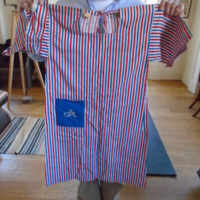Browse Exhibits (1 total)
Draped in Ideology: Clothing and Politics

American citizens have a long history of joining the fashionable and the political in order to convey ideologies to those around them. Today it is a common occurrence, especially during elections, to see individuals wearing campaign shirts, hats, or buttons. The five items in this exhibit are examples of how citizens promote their candidates during elections, local and national. Wearing these items may seem like a recent concept, but Americans have been using clothing to convey their personal beliefs since colonization. In the decades, leading up to the American Revolution fashion became simplified, not just out of necessity, but also as a social commentary on the changing ideals of independence and equality.Patriots embraced these changes in clothing by promoting homespun, local fabrics as a way to maintain autonomy from foreign manufacturing and in essence, the monarchy.
The history of campaign paraphernalia goes back to George Washington, when sew-on-buttons were manufactured to commemorate his 1789 inauguration. The election between Andrew Jackson and John Quincy Adams in 1828, forty years after Washington’s buttons, is hailed as the first presidential election where both men appealed to citizens on a national level. Jackson’s strategy was to hold events and give out campaign trinkets such as medals and snuffboxes. This tradition continued and only gained popularity among politicians and citizens in all levels of government, which can be seen in the wide array of political clothing within this exhibit.
Wearing campaign material is a way to endorse a particular candidate as well as displaying membership to certain communities, which can be advantageous for politicians when they want to promote their own social inclusivity. This is most apparent when politicians pander to certain demographics, as evident with the LGBT themed shirt in this exhibit, which features the Bernie Sanders logo in the recognizable LGBT rainbow, sold during his 2016 presidential campaign. Building communities are most evident in local elections, where clothing is given out to residents of districts and cities. In smaller communities wearing politicized clothing has even more power because there are often personal relationships with the candidate as seen with the Springfield, Illinois specific Langfelder Family items as well as the jacket worn by Mrs. Hunter during her husband’s 1978 campaign for the U.S. House of Representatives.
The act of providing campaign items has become a lucrative trade during elections. Not only are politicians able to market their candidacy by creating logos and catch phrases but by wearing these items citizens show their allegiance as well as promote their candidate. With the expansion of online shopping, Presidential candidates have been able to benefit from selling their own trinkets, usually returning the income to their campaign funds. This was pioneered by Barack Obama’s campaign, with the sale of merchandise earning the President’s 2012 bid for re-election, 40 million dollars.
Clothing as a means of political expression is such a powerful tool in America that in 1992 the Supreme Court ruled that allowing election merchandise to be worn at polling places was a means of voter influence. Citizen’s sartorial choices will always be an important aspect of elections and society. Even without candidate specific apparel, the “I Voted” stickers provided at polling places are enough to politicize any outfit, proving to others the fulfillment of one’s civic duty.
